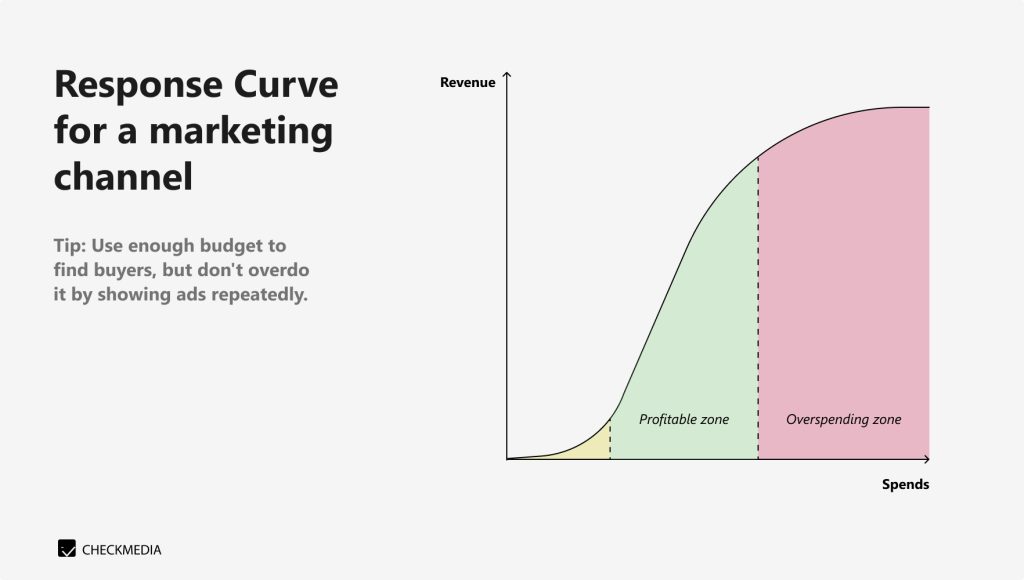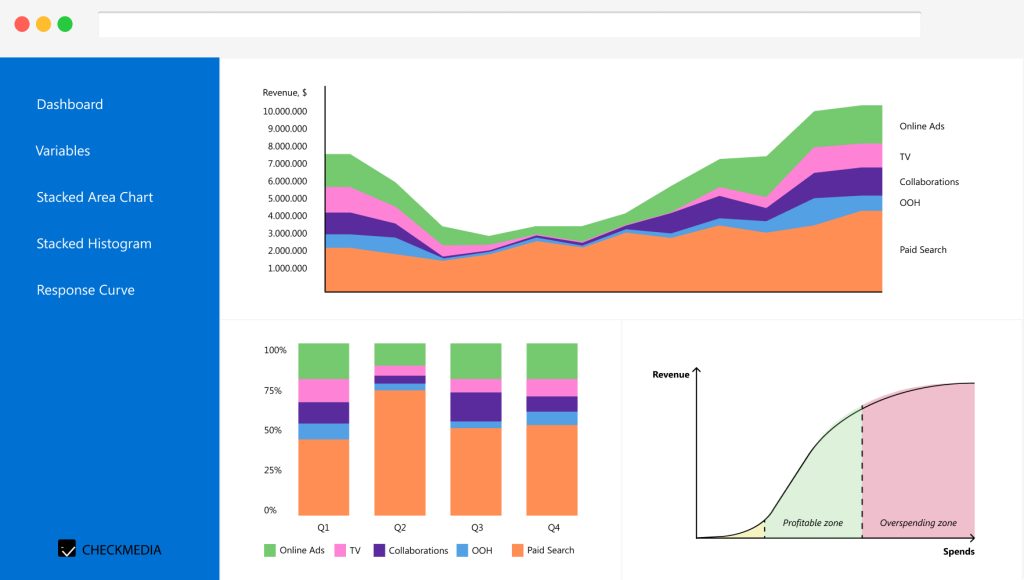
Implement Marketing Mix Modeling in Four Steps
Part of the money businesses spend on growth unfortunately is wasted. In attempts to minimize the waste companies use various tools to understand what activities really work. Every approach has some limitations and even the widely used multi-touch attribution method is losing its effectiveness with elimination of third-party cookies.
Luckily, Marketing Mix Modeling algorithms only need aggregated data to function and don’t rely on cookies, that’s why they remain an accurate and reliable tool in the current situation. In this article you will learn about how Marketing Mix Modeling works, what advanced solutions are available and how MMM can help you to boost company performance or optimize budgets.
72% of companies fail to calculate the right marketing budget for a product launch. Try our AI-copilot to learn if your planned budget is enough to acquire the target number of customers. Get a competitive edge with a valid primary Go-to-Market strategy.
What is marketing mix modeling?
Definition
Marketing mix modeling is a statistical analysis technique used to assess the impact of various elements on sales and overall performance. It involves analyzing and quantifying the influence of different variables like product pricing, distribution channels, advertising, and promotions on target business outcomes.
Why use Marketing Mix Modeling?
The main goal is to optimize sales strategies by understanding how different factors contribute to success or identify areas that may need adjustment. Marketing mix modeling helps companies optimize their promotion budgets to achieve target business outcomes.
With continuous data collection and MMM updates it’s possible to eventually implement FP&A and make adjustments to the future budget allocation and media mix so that it generates maximum sales, conversions or other business results. This next-generation intelligent planning process guarantees optimal use of resources and enhanced performance.
That’s how companies of different size and at different growth stages can benefit from Marketing Mix Modeling:
Startups
Startups can use Marketing mix modeling to develop a roadmap to achieving business goals. Even though startups don’t have their own historical data yet for MMM building, they can rely on a metamodeling approach that uses industry benchmarks and other companies’ data. By doing so startups can save time and money on hypothesis testing, for example calculate short- and long-term revenue, forecast return on investments (ROMI), calculate budgets and create a comprehensive growth strategy.
Investors always require startups to provide a valid strategy, so without accurate calculations it’s almost impossible to raise funds. That’s why using MMM is so important for startups at pre-seed and seed funding stages.
SMBs
If an SMB is trying to create a promotion strategy with a limited budget, MMM is a perfect fit in such a case. The company will be able to select the most effective pricing strategy and promotion activities that will allow it to scale the product and achieve exponential sales growth even with limited resources. Marketing Mix Modeling could be a solution that moves an SMB company to the next level.
Enterprises
To maximize the effectiveness of a company’s promotional efforts: budget optimization, find the best marketing mix including the most effective channels. Marketing Mix Modeling helps to increase ROAS, optimize budget allocation across online and offline channels, and find suitable tools for both short- and long-term sales increase. Including MMM in the performance measurement toolkit gives businesses a competitive edge over their competitors.
Marketing Mix Modeling advantages
- This analytical approach complies with data privacy regulations, because it uses aggregated data and doesn’t rely on 3rd party cookies.
- It can measure the contribution not only of digital media, but also offline channels and even non-media factors like seasonality and macroeconomic situation.
- MMM can also calculate the effect of one channel on others.
Advantages of CheckMedia MMM solution
- Our marketing mix models pass an extended list of statistical tests, which makes them more accurate.
- We have vast experience in various business verticals (finance, pharma, real estate, ecom, retail, media, etc.)
- We have worked on over 50 projects with media budget from hundreds of thousand $ to hundreds of millions $
- We offer metamodeling solutions for cases without client’s historical data. Our metamodels are built using average actual data and industry benchmarks. This solution allows you to benefit from vast experience in strategic marketing from all the projects we’ve worked on. We will help you to create an effective go-to-market strategy and allocate budget across channels for similar products. This approach makes ROAS and ROMI much more significant than random budget allocation.
How to do marketing mix modeling
We recommend approaching MMM as a team that includes a marketer and experienced analysts, especially if you choose open source solutions that require deep understanding of this analytics tool and programming skills. Company marketer can manage sales and promotion data collection, to make sure the dataset is complete. An analyst with experience in Marketing Mix Modeling makes sure that the built MMM functions properly, passes all statistical tests and generates accurate and relevant results.
Marketing mix modeling algorithms

Marketing mix modeling implementation can be divided into 4 steps:
- Data collection: Before statistical analysis starts, another crucial step comes. It’s important to gather enough high quality data, process it and prepare for the next step. The ideal amount of data should cover 2 years of advertising activities and sales. The quality of measurements and analysis depend on data quality, so there should be no errors or missed parts in the data collected. An experienced data analyst can check the data quality and compensate for missing parts.
- MMM building: This step is highly technical and requires experienced analysts. Part of the data is used to train the model (usually 80%). The data is analyzed to find how TV ads, SMM, pricing, weather, etc. affected the sales, the number of new customers or other metrics. After that the model makes a forecast of how it sees future performance metrics with a given budget, and the rest 20% of data is used to test the forecast accuracy. Then analysts run a number of statistical tests that will guarantee that the obtained results aren’t random. You can read more about the MMM building process in this article.
- Analysis of results: Marketing mix modeling results can be visualized for convenient interpretation. Some tools generate tables, others visualize results in the form of dashboards. Analysis shows the contribution of each channel to business outcomes, return on investments, effective range of spends per channel and other insights.
- Marketing Mix Optimization: Based on the modeling results, budget allocation and media mix for future periods can be optimized to maximize sales or other target business outcomes. By regularly inputting actual data, the team can rebuild and adjust the MMM so that it remains accurate.
Collecting variables

Marketing Mix Modeling is a comprehensive analytical approach that takes into account not only media factors affecting sales or the number of new customers, but also seasonality, macroeconomic situation, and mutual effect of channels on one another. You can see a list of factors that can be taken into account in the picture above.
Building a model
Models are built using a regression analysis approach. Regressions are made to identify the relationship between advertising metrics and target business outcomes. Analysts apply nonlinear transformations to the metrics based on industry benchmarks to take into account the adstock effect and channel saturation.
Models are validated by passing a number of statistical tests. Here are some of them:
- MAPE – mean average percentage error. If MAPE value is < 10, it indicates a high accuracy;
- the coefficient of determination (R²);
- Ljung-Box and Shapiro-Wilk test to check for unaccounted autocorrelation of time series and make sure that residuals are normally distributed accordingly;
- Ramsey’s RESET test to determine whether the functional form of the regression is appropriate;
- VIF to check for multicollinearity;
- Augmented Dickey–Fuller test (ADF) for stationarity of residuals in time series.
Marketing mix modeling example
Stacked Area Chart

The graph shows the contribution of advertising channels to sales, revenue and other target business outcomes.
As a short-term analysis it can be used to measure the contribution of various ads and other promo activities to sales.
Response Curve

This prescriptive model allows you to measure the saturation level of each channel in your marketing mix and identify saturation points. With this graph there is no need to guess whether it’s necessary to increase investments in a certain channel or to stop pouring money into it.
Stacked Histogram

This graph perfectly describes market share per promotional channel.
Marketing mix modeling analysis
At this stage companies get the needed insights about performance and effectiveness of promotional activities.
MMM can help to measure the long-term effect of advertising on brand awareness level among the target audience and on building a loyal customer base that sticks to your product even without promotional incentives.
Marketing Mix Modeling can also measure nonlinear response growth, diminishing returns on ad spend, advertising adstock, lagged effect of advertising.
Main insights that MMM can provide is the required budget to achieve the desired target business outcomes. Companies can calculate an optimal level of investments per channel with response curves. The tool also enables businesses to create an optimal media mix for their specific case and goals and understand what are the main sales drivers in their marketing mix.
If you are already using Marketing Mix Modeling, you might want to ask your team the following questions:
- Is the input data rich enough to make reliable conclusions?
- Do forecasts seem reliable and realistic?
- Do model forecasts for historic periods match actual data?
- Can these results be replicated for future sales strategies?
Marketing mix modeling optimization

If your MMM has successfully passed all statistical tests, you can confidently use it for the following optimization purposes:
- forecasting the contribution of media factors on sales (promo activities, pricing, media mix, seasonality, product features) to improve your current media mix;
- identifying the best budget allocation scenarios to achieve target sales values;
- forecasting revenue and ROMI for business planning and fundraising.
Top marketing mix modeling companies
There are open source MMM solutions by Meta and Google that are a perfect fit for you if you have analysts and data science experts as well as staff with programming skills.
There are also solutions with convenient user interfaces that are more easy to handle and don’t require programming skills to operate. Solutions like CheckMedia MMM or Sellforte are good examples of such platforms.
Relevant articles you might be interested in:
- A detailed comparison of using Robyn (an open source solution by Meta) and MMM distributed by CheckMedia with system screenshots and a step-by-step guide through the process.
- Three advanced AI-based MMM tools with a complete description of modeling, optimization and reporting capabilities.
Try our AI-copilot and create an impressive primary Go-to-Market Strategy with Marketing Mix Modeling capabilities. If necessary, you can later purchase advanced access to full-scale capabilities of CheckMedia MMM.



